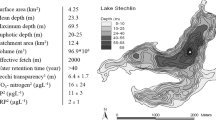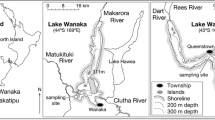Abstract
This study demonstrated how the impact of eutrophication in a deep lake at the southern border of the Alps (Lake Garda) was regulated by specific modes of atmospheric circulation relevant for the Mediterranean area. At the decadal scale, nutrients and phytoplankton increased concurrently since the 1970s. At the annual scale, year-to-year fluctuations in nutrients and phytoplankton were controlled through a chain of causal factors centred on deeply penetrative mixing events determining an upward transport of phosphorus from the hypolimnion to the trophogenic layers. The extent of mixing was in turn controlled by lake and air winter temperature, which were ultimately regulated by the winter fluctuations of the East Atlantic pattern (EA). In its negative state, the EA shows an intense high pressure over the West Atlantic, causing a north-easterly air flow bringing cold air from continental Europe to Mediterranean, thus favouring greater lake mixing and nutrient fertilisation. Cyanobacteria (mostly Planktothrix rubescens) were the organisms which greatly benefitted from the long-term increase in phosphorus concentrations and the year-to-year fluctuations in surface phosphorus availability controlled by the EA. Given the same availability of phosphorus in the water column, positive winter EA phases weakened the eutrophication effects and phytoplankton development.







Similar content being viewed by others
References
Adrian, R., C. M. O’Reilly, H. Zagarese, S. B. Baines, D. O. Hessen, W. Keller, D. M. Livingstone, R. Sommaruga, D. Straile, E. Van Donk, G. A. Weyhenmeyer & M. Winder, 2009. Lakes as sentinels of climate change. Limnology and Oceanography 54: 2283–2297.
APHA, AWWA & WEF, 1995. Standard Methods for the Examination of Water and Wastewater, 19th ed. American Public Health Association, Washington.
Blenckner, T. & D. Chen, 2003. Comparison of the impact of regional and North Atlantic atmospheric circulation on an aquatic ecosystem. Climate Research 23: 131–136.
Blenckner, T., R. Adrian, D. M. Livingstone, E. Jennings, G. A. Weyhenmeyer, D. G. George, T. Jankowski, M. Järvinen, C. N. Aonghusa, T. Nõges, D. Straile & K. Teubner, 2007. Large-scale climatic signatures in lakes across Europe: a meta-analysis. Global Change Biology 13: 1314–1326.
Burnham, K. P. & D. R. Anderson, 2004. Multimodel inference: understanding AIC and BIC in Model Selection. Sociological Methods and Research 33: 261–304.
Chorus, I., I. R. Falconer, H. J. Salas & J. Bartram, 2000. Health risks caused by freshwater cyanobacteria in recreational waters. Journal of Toxicology and Environmental Health, Part B 3: 323–347.
Conrad, K. F., I. P. Woiwod & J. N. Perry, 2003. East Atlantic teleconnection pattern and the decline of a common arctiid moth. Global Change Biology 9: 125–130.
D’Alelio, D. & N. Salmaso, 2011. Occurrence of an uncommon Planktothrix (Cyanoprokaryota, Oscillatoriales) in a deep lake south of the Alps. Phycologia 50: 379–383.
deCastro, M., M. Gomez-Gesteira, M. N. Lorenzo, I. Alvarez & A. J. C. Crespo, 2008. Influence of atmospheric modes on coastal upwelling along the western coast of the Iberian Peninsula, 1985 to 2005. Climate Research 36: 169–179.
Dillon, P. J. & F. H. Rigler, 1974. The phosphorus–chlorophyll relationship in lakes. Limnology and Oceanography 19: 767–773.
George, D. G., 2007. The impact of the North Atlantic oscillation on the development of ice on Lake Windermere. Climatic Change 81: 455–468.
George, G. (ed.), 2010. The Impact of Climate Change on European Lakes. Springer, Dordrecht.
Goldman, C. R. & A. Jassby, 1990. Spring mixing depth as a determinant of annual primary production in lakes. In Tilzer, M. M. & C. Serruya (eds), Large Lakes. Ecological Structure and Function. Springer-Verlag, New York: 125–132.
Hatzaki, M., H. A. Flocas, D. N. Asimakopoulosa & P. Maheras, 2007. The eastern Mediterranean teleconnection pattern: identification and definition. International Journal of Climatology 27: 727–737.
Huber, V., R. Adrian & D. Gerten, 2008. Phytoplankton response to climate warming modified by trophic state. Limnology and Oceanography 53: 1–13.
Hurrell, J. W., Y. Kushnir, G. Ottersen, & M. Visbeck, 2003. The North Atlantic Oscillation. Climatic Significance and Environmental Impact. Geophysical Monograph 134. American Geophysical Union, Washington.
Josey, S. A. & R. Marsh, 2005. Surface freshwater flux variability and recent freshening of the North Atlantic in the eastern subpolar gyre. Journal of Geophysical Research 110: C05008.
Josey, S. A., S. Somot & M. Tsimplis, 2011. Impacts of atmospheric modes of variability on Mediterranean Sea surface heat exchange. Journal of Geophysical Research 116: C02032.
Lehmann, A., K. Getzlaff & J. Harlaß, 2011. Detailed assessment of climate variability in the Baltic Sea area for the period 1958 to 2009. Climate Research 46: 185–196.
Livingstone, D. & M. Dokulil, 2001. Eighty years of spatially coherent Austrian lake surface temperatures and their relationship to regional air temperature and the North Atlantic Oscillation. Limnology and Oceanography 46: 1220–1227.
Luoto, T. P. & S. Helama, 2010. Palaeoclimatological and palaeolimnological records from fossil midges and tree-rings: the role of the North Atlantic Oscillation in eastern Finland through the Medieval Climate Anomaly and Little Ice Age. Quaternary Science Review 29: 2411–2423.
Manca, M. & W. R. DeMott, 2009. Response of the invertebrate predator Bythotrephes to a climate-linked increase in the duration of a refuge from fish predation. Limnology and Oceanography 54: 2506–2512.
Meis, S., J. Thackeray & D. Jones, 2009. Effects of recent climate change on phytoplankton phenology in a temperate lake. Freshwater Biology 54: 1888–1898.
Morabito, G., 2007. Variazioni climatiche interannuali e dinamica stagionale del fitoplancton nel Lago Maggiore. In Carli, B., G. Cavarretta, M. Colacino & S. Fuzzi (eds), Clima e Cambiamenti Climatici: le attività di ricerca del CNR. Consiglio Nazionale delle Ricerche, Roma: 617–620.
Mosello, R., A. Calderoni & R. De Bernardi, 1997. Research on the evolution of the deep southern subalpine lakes performed by the CNR Istituto Italiano di Idrobiologia. Documenta Istituto Italiano di Idrobiologia 61: 19–32. (in Italian).
Padisák, J., E. Soróczki-Pintér & Z. Rezner, 2003. Sinking properties of some phytoplankton shapes and the relation of form resistance to morphological diversity of plankton—an experimental study. Hydrobiologia 500: 243–257.
Pinheiro, J. C. & D. M. Bates, 2000. Mixed-Effects Models in S and S-Plus. Springer-Verlag, New York.
R Development Core Team, 2011. R: A Language and Environment for Statistical Computing. R Foundation for Statistical Computing, Vienna. ISBN 3-900051-07-0 [available on internet at http://www.R-project.org/].
Rott, E., N. Salmaso & E. Hoehn, 2007. Quality control of Utermöhl based phytoplankton biovolume estimates—an easy task or a Gordian knot? Hydrobiologia 578: 141–146.
Salmaso, N., 2005. Effects of climatic fluctuations and vertical mixing on the interannual trophic variability of Lake Garda, Italy. Limnology and Oceanography 50: 553–565.
Salmaso, N., 2011. Interactions between nutrient availability and climatic fluctuations as determinants of the long-term phytoplankton community changes in Lake Garda, Northern Italy. Hydrobiologia 660: 59–68.
Salmaso, N., 2012. Influence of atmospheric modes of variability on the limnological characteristics of a deep lake south of the Alps. Climate Research 51:125–133. doi:10.3354/cr01063.
Salmaso, N. & R. Mosello, 2010. Limnological research in the deep southern subalpine lakes: synthesis, directions and perspectives. Advances in Oceanography and Limnology 1: 29–66.
Salmaso, N., G. Morabito, L. Garibaldi & R. Mosello, 2007. Trophic development of the deep lakes south of the Alps: a comparative analysis. Fundamental and Applied Limnology 170: 177–196.
Schroeder, K., S. A. Josey, M. Herrmann, L. Grignon, G. P. Gasparini & H. L. Bryden, 2010. Abrupt warming and salting of the Western Mediterranean deep water after 2005: atmospheric forcings and lateral advection. Journal of Geophysical Research 115: C08029.
Simona, M., 2003. Winter and spring mixing depths affect the trophic status and composition of phytoplankton in the northern meromictic basin of Lake Lugano. Journal of Limnology 62: 190–206.
Solberg, B. Ø., A. Hofgaard & H. Hytteborn, 2002. Shifts in radial growth responses of coastal Picea abies induced by climatic change during the 20th century, central Norway. Ecoscience 9: 79–88.
Stenseth, N. C., G. Ottersen, G. W. Hurrell, A. Mysterud, M. Lima, K.-S. Chan, N. G. Yoccoz & B. Ådlandsvik, 2003. Studying climate effects on ecology through the use of climate indices: the North Atlantic Oscillation, El Niño Southern Oscillation and beyond. Proceedings of the Royal Society B: Biological Sciences 270: 2087–2096.
Straile, D., 2000. Meteorological forcing of plankton dynamics in a large and deep continental European lake. Oecologia 122: 44–50.
Straile, D., D. M. Livingstone, G. A. Weyhenmeyer & D. G. George, 2003. The response of freshwater ecosystems to climate variability associated with the North Atlantic Oscillation. In Hurrell, J. W., Y. Kushnir, G. Ottersen & M. Visbeck (eds), The North Atlantic Oscillation. Climatic Significance and Environmental Impact. American Geophysical Union, Washington: 263–279.
Straile, D., E. Reiner, T. Jüngling, G. Thomas & H. Löffler, 2007. Influence of climate variability on whitefish (Coregonus lavaretus) year-class strength in a deep, warm monomictic lake. Oecologia 151: 521–529.
Toreti, A., F. Desiato, G. Fioravanti & W. Perconti, 2010. Seasonal temperatures over Italy and their relationship with low-frequency atmospheric circulation patterns. Climatic Change 99: 211–227.
Woolf, D. K., P. G. Challenor & P. D. Cotton, 2002. The variability and predictability of North Atlantic wave climate. Journal of Geophysical Research 107: 3145.
Acknowledgments
We wish to thank the colleagues at IASMA Research and Innovation Centre, S. Michele all’Adige, University of Padova and ARPAV (Environment Protection Agency of the Veneto Region) for their help and logistic support. This research was funded in part by the Veneto Region, ARPAV and the EU Central Europe Programme (EULAKES Project, 2CE243P3). We thank two anonymous referees for comments and suggestions.
Author information
Authors and Affiliations
Corresponding author
Additional information
Guest editors: N. Salmaso, L. Naselli-Flores, L. Cerasino, G. Flaim, M. Tolotti & J. Padisák / Phytoplankton responses to human impacts at different scales: 16th workshop of the International Association of Phytoplankton Taxonomy and Ecology (IAP)
Rights and permissions
About this article
Cite this article
Salmaso, N., Cerasino, L. Long-term trends and fine year-to-year tuning of phytoplankton in large lakes are ruled by eutrophication and atmospheric modes of variability. Hydrobiologia 698, 17–28 (2012). https://doi.org/10.1007/s10750-012-1068-2
Received:
Accepted:
Published:
Issue Date:
DOI: https://doi.org/10.1007/s10750-012-1068-2




